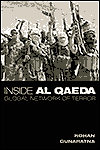|
| Home | About Kashmir Herald | |
Volume 2, No. 8 - January 2003 |
|
| Featured Article |
|
|
|
Jammu &
Kashmir: Suicide Terror The lethality of any terrorist group is proportionate to the effective strategies that it unveils and the levels of violence it can inflict upon a target society. Suicide terrorism is now widely considered a relatively cost-effective, high-impact tactic in various theatres of conflict, including, over the past three years, in Jammu and Kashmir (J&K). 338 persons have been killed and another 432 injured during suicide [fidayeen] attacks [Table] between July 1999 and November 2002. On November 29, 2002, a Deputy Inspector General of the Border Security Force (BSF), R.S. Bhullar, disclosed that suicide attacks had claimed the lives of 161 security force (SF) personnel in J&K over the last three years. Ninety terrorists and an almost similar number of civilians have also died in these fidayeen strikes. He also said that Pakistan-based terrorist formations had carried out as many as 55 suicide attacks on Police and SF camps. The Army had suffered the maximum casualties, losing 82 personnel; the J&K Police suffered 42 fatalities; the Central Reserve Police Force (CRPF) lost 24; while Border Security Force (BSF) lost 10 men. Two personnel of the Indo-Tibetan Border Police (ITBP) and one of the Indian Air Force (IAF) have also died in these attacks. The Pakistan-based Lashkar-e-Toiba (LeT) has been responsible for a majority of the suicide attacks. Between November 3, 1999 and December 31, 2000, LeT was involved in 15 out of an estimated 19 fidayeen attacks in J&K, in which 50 SF personnel were killed and another 37 injured, with three civilian casualties. 24 Lashkar terrorists were killed during these attacks. In the year 2001, the LeT executed 23 out of an estimated 28 fidayeen attacks in J&K, killing 83 SF personnel, and injuring another 135. Civilians also lost their lives in these incidents and 59 were injured. 29 LeT cadres died during these operations. The Lashkar has also been responsible for at least 10 fidayeen attacks in the current year. One of the high-intensity strikes was the September 24-attack on the Akshardham Temple of the Swaminarayan sect of Hindus in the western Indian State of Gujarat. Although a crack team of the National Security Guards (NSG) eventually killed both the Lashkar fidayeen, 32 persons, including 16 women and four children, had already lost their lives, and at least another 74 had been injured. Again, on November 24, 2002, at least 12 persons were killed and 45 others injured, when three LeT fidayeen simultaneously attacked two shrines – Raghunath and Panjbakhtar temples – in the heart of Jammu City. Violence recommenced briefly around the Panjbakhtar temple the next morning when a third terrorist, presumed to be part of the same squad was engaged and neutralized by the by SFs. J&K Director General of Police A.K. Suri indicated that the LeT was responsible for this attack, the second in eight months on the Raghunath temple. This information was derived from a telephone call received by Suri at his residence in which a "Pakistani LeT cadre" said, "we have done it and now it is your turn." The first fidayeen attack in the State occurred on July 13, 1999, when six BSF personnel, including a Deputy General of Police (DIG), were killed in a sneak operation at the Sector 11 headquarters at Bandipore. Over the next three years, terrorists have carried out similar successful suicide attacks on a large number of high-value military and civil installations, including the headquarters of the Army’s 15 Corps at Badami Bagh in Srinagar, the headquarters of Special Operations Group (SOG) in Srinagar, the Police Control Room in Srinagar, J&K Legislative Assembly complex in Srinagar, Srinagar Airport, the Indian Air Force base at Awantipore, and the headquarters of 19-Infantry Division in Baramulla. The latest strike on an SF concentration occurred when, in its first suicide attack in Srinagar during the current year, LeT fidayeen, on November 22, killed six SF personnel and injured another nine, at the headquarters of the CRPF’s 113 and 92 battalions in the Pamposh Hotel premises of the high security Civil Lines area. Both the terrorists of the group were killed in retaliatory firing. This was also the first major terrorist attack after the new coalition government headed by Mufti Mohammad Sayeed took office on November 2. An unidentified LeT spokesperson reportedly claimed the incident was part of the group’s ‘Operation Badar’, which had been launched in the holy month of Ramzan. Suicide terror in J&K is not merely a measure undertaken out of tactical despondency, nor is it a measure of last resort. Pakistan-based terrorist groups introduced suicide attacks on security installations in J&K after the Kargil War in year 1999. In mid-1999, army units were moved from the Kashmir valley to Kargil sector for duties under Operation Vijay. Taking advantage of the momentary disruption in the counter-insurgency grid as also the resulting gaps in deployment, terrorist groups began sneak attacks on security force formations. Eric Herren of the International Policy Institute for Counter-Terrorism while observing that Kashmir presented a particularly difficult problem vis-à-vis suicide bombings says, "It is becoming something of a mass movement among terrorists… Almost every mission is a success." According to Herren, the suicide terrorist in J&K is likely to be "between 15 and 25 years of age, male, and may be Kashmiri but is most likely to be Pakistani, Afghan, Arab or a European-born Muslim." The general pattern of fidayeen attacks carried out by the LeT is directed towards storming a particular target, inflicting maximum fatalities, before death (or occasional escape) intervenes. Though fidayeen targets have often been security installations, civilian targets are far from the exception. The Lashkar attack on August 7, 2001, at the Jammu Railway Station was the first suicide attack in the State that targeted civilians. The attack left seven civilians dead and another 24 injured. The second, and arguably the most lethal attack thus far, was the Jaish-e-Mohammed’s (JeM) strike on the J&K State Legislative Assembly complex in Srinagar, in which 36 persons were killed and 24 others injured. On May 14, 2002, three fidayeen of the Al Mansooran, a front outfit of the Lashkar, launched an attack on the Kaluchak cantonment in Jammu. 36 persons, a majority of them family members of SF personnel and other civilians, were killed, while 48 others were injured. The two attacks on Raghunath temple this year and the Akshardham incident also fall under this category. In a majority of attacks, most fidayeen were killed, though a few did manage to escape. It was only in nine incidents that the complete suicide squad managed to escape while in two attacks, they failed to inflict any fatalities. The suicide attack on the Legislative Assembly complex in Srinagar, in addition to being one of the most daring attacks, also demonstrated the tactical use of a vehicle-borne suicide bomber in a larger terrorist attack. The objective of the fidayeen was to blow open the gates to the complex in order to allow the back-up team to enter and eliminate members of the Assembly. The most dramatic and consequential of fidayeen attacks, however, was the December 13, 2001 attack on India’s Parliament at Delhi, which led to the mobilization of Forces and deployment along the Line of Control and International Border by both countries, arousing international apprehensions of an open – and potentially nuclear – war. A group of five JeM terrorists, armed with guns and hand grenades, stormed the Parliament complex with an explosives-laden car shortly before noon on December 13, and in the indiscriminate firing, nine SF personnel and a member of the Parliament staff were killed. All five terrorists were subsequently killed by the SFs. The Pakistani terror machinery appears to regard the fidayeen option as attractive and Mohammed Nawaz alias Abu Hijrat, who was an instructor at an Afghanistan training camp, disclosed in August 2000 that hardcore terrorists, primarily murderers, criminals under death sentence, and religious fanatics were being inducted into suicide squads and given training at such camps. Hijrat also revealed that mercenaries secure a special three-month training for graduating to suicide squads at Umal Basti in Muzaffarabad, Pakistan occupied Kashmir (PoK) and Bagalpur in Pakistan. A fidayeen is given training in special acts of sabotage after his three-month commando course and three months of special training on mapping, surveillance, civilian cooperation and intelligence gathering at Bagalpur, Zafarwal and Umal Basti camps, among others. A suicide attack involves a minimal security risk for its sponsors, since the impossibility of interrogating the attacker leaves the terrorist infrastructure intact. In addition to the physical destruction caused, suicide attacks also carry psychological ramifications for the target society at large, delivering a message that the enemy is willing to pursue and resort to the most extreme measures at its disposal. The extension of the fidayeen strategy to other theatres outside J&K also indicates that no place or category of persons is secure. Countering the fidayeen, evidently, presents a difficult problem for security agencies. In the J&K case, where the entire mobilization, training and planning of the attacks takes place on foreign soil, in Pakistani safe havens, it is not possible to ‘work backstage’ on the organization that prepares the fidayeen for their macabre missions. Nor, indeed, would the various long-term strategies recommended – including 'de-indoctrination' and counter-propaganda targeting either the terrorist political agenda or the religious/ideological logic of martyrdom, undercutting the recruitment capability of a terrorist group by removing the necessary ideological or religious fuse – have significant potential for success, until the supporting state structure in Pakistan is brought under extraordinary pressure to end the exploitation of an impoverished and ignorant population to recruit a continuous stream of volunteers and mercenaries whose only way of escape is in such suicidal acts of violence. Courtesy: South-Asia Terrorism Portal |
 |
 |
 |
|
|
Archives
| Privacy Policy |
Copyrights
|
Contact
Us | |
||